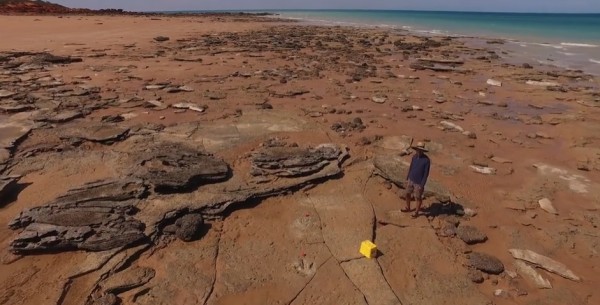By Ana Verayo, | March 28, 2017

Lead author Dr Steve Salisbury of The University of Queensland School of Biological Sciences discusses the diversity of tracks around Walmadany in Western Australia.
A team of researchers was able to to uncover one of the most important findings in Australia, which are different kinds of dinosaur footprints along a coastline stretch. Scientists now dub this incredible fossil discovery as "Australia's Jurassic Park". Paleontologists also say that these are some of the biggest dinosaur footprints in the world.
Like Us on Facebook
Scientists from the University of Queensland also reveal that these footprints do not only belong to one dinosaur species, but to a diverse range of dinosaurs appearing to have walked together or perhaps eaten each other, along the Dampier Peninsula coastline.
This coast stretches for about 15 miles called Walmadany where researchers have discovered 150 tracks. Upon identification, scientists found that they belong to 21 different dinosaur species.
According to lead author of the study, Steve Salisbury from the University of Queensland, this is the Cretaceous equivalent of the Serengeti, which is extremely significant. This fossil record provides the only glimpse of Australia's dinosaurs during the first half of the Cretaceous period, making this the primary fossil record of non-avian dinosaurs in the western part of the continent.
'Australia's Jurassic Park' the world's most diverse from The University of Queensland on Vimeo.
These dinosaur tracks were discovered within sedimentary rock from 127 to 140 million years old. Dinosaur fossils that are often uncovered in Australia originate from 90 to 115 million years ago, which makes these newly uncovered dinosaur footprints the oldest evidence yet of these ancient creatures.
Salisbury reveals that there were five different types of predatory dinosaur tracks where at least six of them are from long necked sauropods. There were also four types of footprints from two legged herbivorous ornithopods and six kinds of tracks from armored dinosaurs.
This also means that these sets of footprints are the only evidence of the existence of the stegosaurus in Australia, also making them the largest dinosaur tracks ever recorded.
In order to explore and examine the land, the University of Queensland team was invited by an aboriginal group known as the Goolarabooloo people who has been living in the region before European settlers arrived in Australia. To the Goolarabooloo, this land, specifically its coastline is considered as a sacred, spiritual place.
The Western Australian government granted the land the National Heritage status in 2011. This new study is published in the Journal of Vertebrate Paleontology.
-
Use of Coronavirus Pandemic Drones Raises Privacy Concerns: Drones Spread Fear, Local Officials Say

-
Coronavirus Hampers The Delivery Of Lockheed Martin F-35 Stealth Fighters For 2020

-
Instagram Speeds Up Plans to Add Account Memorialization Feature Due to COVID-19 Deaths

-
NASA: Perseverance Plans to Bring 'Mars Rock' to Earth in 2031

-
600 Dead And 3,000 In The Hospital as Iranians Believed Drinking High-Concentrations of Alcohol Can Cure The Coronavirus

-
600 Dead And 3,000 In The Hospital as Iranians Believed Drinking High-Concentrations of Alcohol Can Cure The Coronavirus

-
COVID-19: Doctors, Nurses Use Virtual Reality to Learn New Skills in Treating Coronavirus Patients







